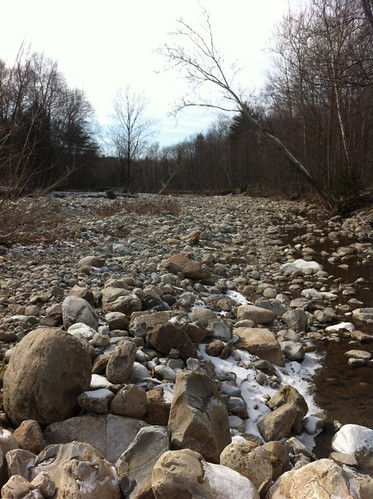
The above map, issued by the Burlington, Vermont National Weather Service, shows an interesting pattern. The areas most hard hit by Irene and other flooding events last year - the Green Mountains in the southern and central parts of the state - are largely the areas most hard hit by this dry weather pattern. For the time being, I haven't heard of any ill effects except for increased fire risk. However, if the dry weather pattern persists into the growing season, it may negatively impact trees and cause problems for farmers.
Dry times in Vermont are an odd thing. In southern California, a dry year means essentially no rain - a winter rainy season of just a few passing showers (still often torrential even if brief, and seemingly often passing at night) followed by a summer of absolutely no rain whatsoever; a trial of waiting with no hope of reprieve until perhaps the next rainy season. Even that holds no true promise, as dry years tend to string together.

Above: the feeble snows of this winter have continued to sporadically dust Vermont into the Spring.
Dry spells in Vermont are different. For one thing, they are usually measured in terms of weeks or months instead of years. Secondly, it still rains and snows. We've had unfulfilling drizzle, sleet, brief downpours, and non-accumulating snow flurries many times in the last two months. After essentially losing their entire snowpack in the March heat wave, the Green Mountains are again frosted with snow. It's just that there hasn't been a lot of it.
The Middlebury River is about as low in level as it was during a brief dry spell last July - with one difference. In early April, trees aren't aggressively taking up water and lowering the water table like they do in July, and there has been little sunshine and no heat to increase evaporation, either. If the dry period continues for another month or two, I'd except the river to drop even more when the trees leaf out.

Above: the same section of river photographed during the July 2011 post linked above. The water level is not directly comparrable because Irene and subsequent actions by the City of Middlebury has altered how water flows through this area. Still, this side branch of the river is nearly dry, and the main part of the river is almost low enough to boulder-hop across.
The flood-scarred but dry bed of the Middlebury River reminds me very much of how rivers look in the dry season in California:

I'd been expecting this oxbow cut to burst through during Spring flood - but we haven't had one!

Meanwhile, I've been dealing with a nasty flu and fever the last few days. Apparently the fever has dried me out as surely as the Vermont hills this last month, and now I'm taking fever reducing medicine and drinking Gatorade to reduce my dehydration. I think it's fascinating how humans (and other animals) are largely composed of water... and that reducing the amount just a little can cause problems. In any event... hopefully I feel better soon.
On a much broader note, evidence has been mounting that the lack of sea ice the Arctic has been experiencing lately has been a factor in increasing jet stream fluctuations that cause weather extremes, especially cold and snow. It seems a bit counter-intuitive that less ice in one place means more snow and cold in other places, but if you read through this post by meteorologist Jeff Masters, or look back at a post i made about the subject last year, it does make sense. The atmosphere is incredibly complex and affected by many factors, which is sometimes used as an argument that humans don't affect the climate. The truth is, it's near-certain that we do have a significant effect, but it is immersed within many natural factors as well. It may be that our warming of the climate melts Arctic ice and causes a feedback loop that throws much of the Northern Hemisphere into a cold period. The climate is incredibly complex, and this means any effect we have may be amplified or distorted in odd ways. In addition to working to reduce our impact, we need to understand and study all kinds of climate change so we can prepare for them as best we can.

No comments:
Post a Comment